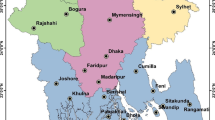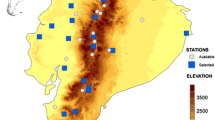Abstract
The El Nino–Southern Oscillation (ENSO) occurrences derive the substantial variability in precipitation which may cause threatening climate change and severe drought occurrence in a specific region. In this present study, the role of ENSO events on changing climatic patterns in the view of drought has been analyzed over the southern peninsular Indian region for the period of 2 decades from 2000 to 2020. The year 2017 stipulated with the Sea Surface Temperature (SST) anomaly of 2.127 °C which is recognized as the Super El Nino year. The SST anomaly for the year 2015 is – 1.824 °C and is recognized as the Strong La Nina year. The climate-based Standardized Precipitation Index (SPI), Rainfall Anomaly Index (RAI), Standardized Precipitation Evapotranspiration Index (SPEI), and Aridity Index (AI) are derived in order to delineate the sensitivity response of climatic patterns on the basis of ENSO. During El Nino-2017, the study region sustained with SPI ranges from – 1.232 to 2.056, RAI ranges from – 3.541 to 4.907, SPEI range from – 1.476 to 1.872, and AI ranges from 0.657–3.891. In La Nina-2015, the study region stipulates SPI ranges from – 2.576 to 1.368, RAI ranges from – 3.546 to 6.495, SPEI ranges from – 1.682 to 1.791, and AI ranges from 1.144 to 4.028. Furthermore, correlation analysis has been performed to ensure their reliability. Accordingly, the indices like SPEI and AI are obtained with relatively high correlation, whereas SPI is discerned with the least correlation. Eventually, this study unveils that the influence of the ENSO pattern varied spatially and El Nino onsets almost lead to arid climatic conditions rather than the La Nina phase.

















Similar content being viewed by others
Change history
09 March 2024
A Correction to this paper has been published: https://doi.org/10.1007/s12524-024-01844-y
References
Ahmad, S., Tamaddun, K. A., Kalra, A., & Bernardez, M. (2019). Effects of ENSO on temperature, precipitation, and potential evapotranspiration of North India’s monsoon: an analysis of trend and entropy. Water Journal, 11, 189. https://doi.org/10.3390/w11020189
Arakawa, O., Ninomiya, J., Mori, N., & Takemi, T. (2017). SST ensemble experiment-based impact assessment of climate change on storm surge caused by pseudo-global warming: case study of typhoon Vera in 1959. Coastal Engineering Journal. https://doi.org/10.1142/S0578563417400022
Azmoodehfar, M. H., & Azarmsa, S. A. (2013). Assessment the effect of ENSO on weather temperature changes using fuzzy analysis (case study: Chabahar). APCBEE Procedia, 5, 508–513.
Barnstone, A.G. (2015). Evolution of ENSO prediction over the past 40 years. Science and technology infusion climate bulletin, NOAA’s National Weather Service.
Bramston, A. G., Chelliah, M., & Goldenberg, S. B. (1997). Documentation of a highly ENSO-related SST region in the equatorial pacific: research note. Atmosphere-Ocean Journal, 35(3), 367–383.
Fang, S., Wang, L., Pei, Z., & Yang, W. (2020). Comparative analysis of drought indicated by the SPI and SPEI at various timescales in inner Mongolia, China. Water Journal, 12, 1925. https://doi.org/10.3390/w12071925
Feng, A., Li, Y., Liu, W., Ma, X., & Dong, G. (2017). Variation of aridity index and the role of climate variables in the Southwest China. Water Journal, 9(10), 743. https://doi.org/10.3390/w9100743
Glantz, M. H., & Ramirez Ivan, J. (2020). Reviewing the oceanic Nino index (ONI) to enhance societal readiness for El Nino’s impacts. International Journal of Disaster Risk Science, 11, 394–403. https://doi.org/10.1007/s13753-020-00275-w
Gushchina, D., Zheleznova, I., Osipov, A., & Olchev, A. (2020). Effect of various types of ENSO events on moisture conditions in the humid and sub humid tropics. Atmosphere Journal, 11(12), 1354.
Huang, B., Thorne, P. W., Banzon, V. F., Boyer, T., Chepurin, G., Lawrimore, J. H., Menne, M. J., Smith, T. M., Vose, R. S., & Zhang, H. M. (2017). Extended reconstructed Sea Surface temperature, version 5 (ERSSTv5): upgrades, validations and intercomparisons. Journal of climate, 30, 8179–8205. https://doi.org/10.1175/JCLI-D-16-0836.1
Khole, M. (2002). Variability of sea surface temperature over Indian Ocean during El-Nino and La-Nina years. Mausam Journal, 54, 829–836.
Li, Y., Strapasson, A., & Rojas, O. (2019). Assessment of El Nino and La Nina impacts on China: Enhancing the early warning system on food and agriculture. Weather and Climate Extremes., 27, 100208.
Liu, W., Zhu, S., Huang, Y., Wan, Y., Wu, B., & Liu, L. (2020). Spatiotemporal variations of drought and their teleconnections with large-scale climate indices over the Poyang Lake Basin, China. Sustainability Journal, 12, 3526. https://doi.org/10.3390/su12093526
Lyon, B., & Barnston, A. G. (2005). ENSO and the spatial extent of interannual precipitation extremes in tropical land areas. Journal of Climate, 18(23), 5095–5109.
McKee, T.B., Doesken, N.J., Kleist, J. (1993). The relationship of drought frequency and duration to time scales. Eighth Conference on Applied Climatology.
Meza, F. J. (2013). Recent trends and ENSO influence on droughts in Northern Chile: an application of the standardized precipitation evapotranspiration index. Weather and Climate Extremes, 1, 1–58.
Myneni, R. B., Los, S. O., & Tucker, C. J. (1996). Satellite-based identification of linked vegetation index and sea surface temperature anomaly areas from 1982 to 1990 for Africa, Australia and South America. Geophysical Research Letters, 23(7), 729–732.
Neha, N., Sandhya Kiran, G., Raman, M., & Ajai. (2013). Comparative analysis of sea surface temperature pattern in the eastern and Western Gulfs of Arabian Sea and the Red Sea in recent past using satellite data. International Journal of Oceanography. https://doi.org/10.1155/2013/501602
NOAA (National Oceanic and Atmospheric Administration). Nino regions. https://www.cpc.ncep.noaa.gov/products/analysis_monitoring/ensostuff/nino_regions.shtml. Accessed 23 Jan 2021.
Ogunjo, S.T., Fuwape, A., Olusegun, C.F. (2019). Impact of large-scale climate oscillation on drought in West Africa. Journal of Hydrology.
Pandey, V., Mishra, A. K., & Yadav, S. B. (2019). Impact of El-Nino and La-Nina on Indian climate and crop production. Climate change and agriculture in india: impact and adaptation (pp. 11–20). Cham: Springer. https://doi.org/10.1007/978-3-319-90086-5_2
Patel, N. R., & Yadav, K. (2015). Monitoring spatio-temporal pattern of drought stress using integrated drought index over Bundelkhand region, India. Natural Hazards Journal, 77, 663–677. https://doi.org/10.1007/s11069-015-1614-0
Pellicone, G., Caloiero, T., & Guagliardi, I. (2019). The De Martonne aridity index in Calabria (Southern Italy). Journal of Maps, 15(2), 788–796. https://doi.org/10.1080/17445647.2019.1673840
Propastin, P.A. (2009). Monitoring system for assessment of vegetation sensitivity to El-Nino over Africa. Advances in GIScience, Proceedings of the 12th AGILE Conference, Hannover, Germany. https://doi.org/10.1007/978-3-642-00318-9_17
Singh, R. M., & Shukla, P. (2020). Drought characterization using drought indices and El Nino effects. National Academic of Science Letter, 43(4), 339–342. https://doi.org/10.1007/s40009-019-00870-6
Thushara De Silva, M., & Hornberger, G. M. (2019). Identifying El Niño-Southern oscillation influences on rainfall with classification models: implications for water resource management of Sri Lanka. Hydrology Earth System Science, 23, 1905–1929. https://doi.org/10.5194/hess-23-1905-2019
Trenberth, K. E. (1997). The definition of El Nino. Bulletin of the American Meteorological Society, 78(12), 2771–2777.
Trenberth, K. E. (2011). Changes in precipitation with climate change. Climate Research Journal, 47, 123–138.
Vincente Serrano, S. M., Begueria, S., & Lopez-Moreno, J. L. (2009). A multiscalar drought index sensitive to global warming: the standardized precipitation evapotranspiration index. Journal of Climate., 23(7), 1696–1718.
Weatherbase. Weather consulting webpage. http://www.weatherbase.com. Accessed 19 July (2021).
Yang, J. A., Kim, S., Son, S., Mori, N., & Mase, H. (2020). Assessment of uncertainties in projecting future changes to extreme storm surge height depending on future SST and greenhouse gas concentration scenarios. Climate Change Journal., 162, 425–442. https://doi.org/10.1007/s10584-020-02782-7
Acknowledgements
Authors are thankful to SRTD-PPG, Space Application Centre (ISRO), Ahmedabad, for providing necessary facilities and guidance to carry out this research work. Also, they would like to acknowledge Department of Geography, Bharathidasan University, Tiruchirappalli, for providing the support to utilize the software to undergo this research work in UGC-SAP-DRS II Laboratory.
Author information
Authors and Affiliations
Corresponding author
Ethics declarations
Conflict of interest
No potential conflict of interest was reported by the author(s).
Additional information
Publisher's Note
Springer Nature remains neutral with regard to jurisdictional claims in published maps and institutional affiliations.
The original online version of this article was revised: Figure 1 was incorrectly published and this has been corrected.
About this article
Cite this article
Deivanayagam, A., Sarangi, R.K. & Palanisamy, M. Evaluating the Influence of El Nino–Southern Oscillation (ENSO) Patterns on the Spatio-Temporal Variations of Drought over Southern Peninsular Indian Region. J Indian Soc Remote Sens 52, 463–484 (2024). https://doi.org/10.1007/s12524-022-01589-6
Received:
Accepted:
Published:
Issue Date:
DOI: https://doi.org/10.1007/s12524-022-01589-6




